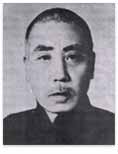
To commemorate this great master of Chen Style Taichi. Following is the article by his student Master Pan Wing Chow.
My Teacher Chen Fu Shen
Chen style TaiChi was developed over six centuries ago by Chen Pu from the Chen village in Wen county, Huh Nan province. My teacher, Chen Fu Shen, also known as Chen Fa Ke, was seventeenth generation Chen family. His father, Chen Ian Xi and his great grand father, Chen Chang Xien, were the famous TaiChi masters.
The sets my teacher taught me are the original forms perfected by his great grand father, Chen Chang Xien, over 200 years ago. My teacher was a big man, but gentle and refined. He was very humble whenever he talked about martial arts even though he was a master. He was a very demanding but also very patient teacher. He was satisfied with a student's performance only when every detail of a move was done correctly.
In the autumn of 1928, my teacher was invited to Peking by ''Huh Nan Peking Tueng Xiang association.'' His nephew Chen Zhao Pei was in Peking also. Chen Zhao Pei left Peking to work for the Nanking city government in 1930. My teacher's second son, brother Xiao Chu other name Zhao Xu, were with him in Peking. They lived in ''Luo Ma Da Jie Tan Huai Huei Guan''. At first he taught only a few student privately, but his reputation spread, many asked for his teaching. The most famous of his students included Shu U Sheng the president of Peking Wu Shu Institute and Yang Xiao Lou, a Chinese Opera celebrity.
I was introduced to my teacher by a close friend of his from Wu Si, Jiang Su province, Liu Mo San, who was himself an expert in Wu style TaiChi. Eight of us included Mr. Liu were honored to be his students in the same ceremony in 1931.
When my teacher first arrived in Peking, Taichi was very popular and arguments over the merits of different styles were common. Many challenged my teacher, but he did not want to be involved. He said he would go back to his home town rather than be involved in these arguments. But the challenges kept coming so he finally decided to accept. A contest was arranged at Chun San park Lai Jien U Xuan. My teacher and his opponent met and touched hands. My teacher ''listened'' and neutralized his opponent's attack, moving backward. He opponent kept approaching until my teacher was almost backed against the wall. Just then, he changed positions with his opponent and lightly pressed him to the ground. Just as quickly, to save his opponent's honor, he pulled him back up. His opponent showed his appreciation and called a truce.
My teacher's skill was so complete, but it was his gentleness in using it that won everyone's respect. Another time, my teacher was explaining how to handle a spear thrust with the agile step and turn of the ''Wild Horse Shakes Its Mane'' movement. His listener would not believe him. To prove the applicability of TaiChi, my teacher proposed a test against a renowned spear master. On the day of the test, at the Zh Men Square of Xi Men, a crowd gathered. At the first thrust, my teacher stood relaxed and still with his hands at his side. He could sense the move was a fake. The spear master then made a real thrust to my teacher's chest. Instantly my teacher turned aside, his hands already on the spear shaft, his leg raised to kick his opponent to the ground. The crowd burst into applause, amazed to see such speed and coordination..
My teacher told us later that what he had done was all based on everyday practice. He had used no secret moves or tricks. The above events were widely discussed through out the martial arts community and brought recognition and legitimacy to Chen Style TaiChi. In 1933, my teacher was invited to the Chinese National Martial Arts conference in Nanking as one of the great masters in the Chinese martial arts community.
My teacher was very honest and sincere in his teaching. He used different examples to help his students learn and inspired all of us to do our very best. It has been many years now since I was studying with him in Peking, but I feel it was only yesterday, and I often think of him and wish that I could see him again. His death in 1957 left me with a deep sadness. I wish him comfort in heaven.
My teacher was born in 1887 and was 71 at his death. His first son, Zhao Ho died young. His second son, Zhao Xu stayed with him and inherited all his art, but unfortunately he died only three years after his father in 1960 at the age of 46. His death was a great loss. My teacher's third and fourth sons, Zhao Xiang and Xao Kuei both learned his art and continue the family tradition. If my teacher knew it he will be happy in heaven.
